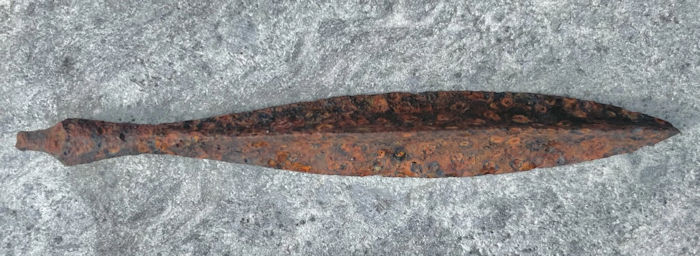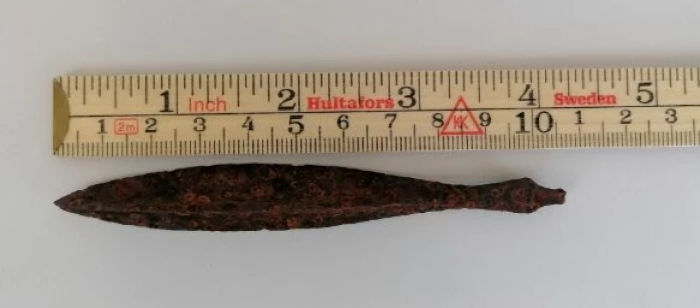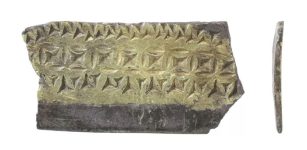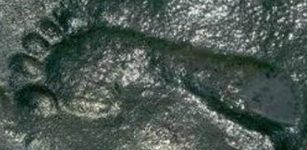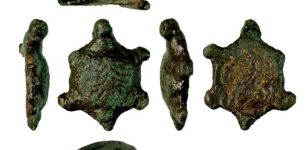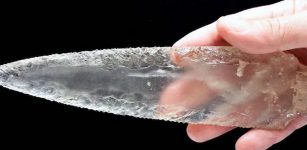Rare Three-Bladed Arrowhead Hidden Under The Ice Was Last Touched By A Viking – Scientists Say
Conny Waters - AncientPages.com - Glacial archaeologists from Secrets of the Ice continue to uncover more artifacts hidden under the ice. The team found this rare three-bladed arrowhead in the Jotunheimen Mountains, Norway, and scientists are certain the last person to touch this object was a Viking.
The arrowhead from the Viking Age melted out of the ice in a new site in the Jotunheimen mountains which was recently surveyed by a team of glacial archaeologists. Photo: Secrets of the Ice
The area was named Jotunheimen, meaning “The Giants home,” by Norwegian poet Aasmund Olavsson Vinje in 1862. Jotunheimen (also spelled Jötunheimr ) was the dwelling place of the giants (Old Norse Jötnar), and it was one of the nine worlds of Norse cosmology. Norse Sagas advise against visiting this dark, inhospitable place surrounded by dark forests and mountain peaks. Even the most courageous Norse Gods feared this place where winter never sleeps.
It is certainly a cold region, but the cold weather and fearsome Norse stories do not stop archaeologists of the Secrets of the Ice from examining the area. Scientists have uncovered many precious ancient artifacts in Jotunheimen Mountainas and many more are awaiting to be discovered.
As reported by Science in Norway, "the team of glacial archaeologists from Innlandet county's Secrets of the Ice and the Museum of Cultural History in Oslo are currently doing their annual field work up in the Norwegian mountains, where melting ice keeps on revealing lost items from our past.
An unknown Viking was the last person who touched the arrowhead, scientists say. Credit: Adobe Stock - sonyachny
The unique arrowhead is from a new site in the Jotunheimen Mountains, where the team was just doing an initial exploratory survey. Finds like this Viking Age arrowhead means they will most certainly be returning.
The arrowhead is made of iron. Its shape indicates that it is typical for the Viking Age, Lars Pilø writes in an email to sciencenorway.no.
“This type of arrowhead is known, but it is rare,” he writes.
Four such arrowheads were found in a burial mound in Sparbu in Trøndelag, and one such arrowhead has also appeard in Leirtjønnkollen in Oppdal – another glacial archaeological site.
Central Jotunheimen. Credit: Jack R. Johanson - CC BY-SA 3.0
“We haven’t tested this, obviously, but it is not unlikely that this sort of arrowhead would have had greater penetration than the arrowheads we normally find. It looks more like a war arrowhead than one made for hunting,” he writes – adding that this of course is pure speculation.
Several of the people who have commented on Facebook suggest the same. Three blades would increase blood loss and stop a wound from potentially closing up. “Either way it’s military/war related,” one reader comments.
“Yes, that is what we are thinking as well. However, it was found in a reindeer hunting site. Perhaps they just grabbed the arrows they had when they went out hunting,” Secrets of the Ice respond.
Broader than your usual combat arrow
Vegard Vike is the Head Engineer of Archaeological Conservation at the Museum of cultural history in Oslo. He is an expert in among other things weapons of the Viking Age.
Vike comments that the arrow is incredibly well preserved.
“Three-bladed arrowheads from the Viking Age are not so common in Norway, they are more commonly found in Sweden,” he writes in an email to sciencenorway.no.
The arrowhead with scale. Photo: Secrets of the Ice
These are however usually slimmer, more like arrowheads made for combat. Some of these combat arrowheads from Sweden and Denmark are decorated and fastened with noble metals.
“The one which is found here I would think is rather made for hunting, as it is so broad,” Vike concludes and explains:
"The reason for why dedicated combat arrows are slim and do not have broad blades is that they needed to penetrate chain mails. More broad-bladed arrows are on the other hand perfect for hunting as they create larger wounds, which means that the animal bleeds out faster. They would however be stopped by a chain mail."
As the Secret of the Ice team continues the investigations, we can expect to learn more about interesting archaeological discoveries in this region soon.
Written by Conny Waters - AncientPages.com Staff Writer

